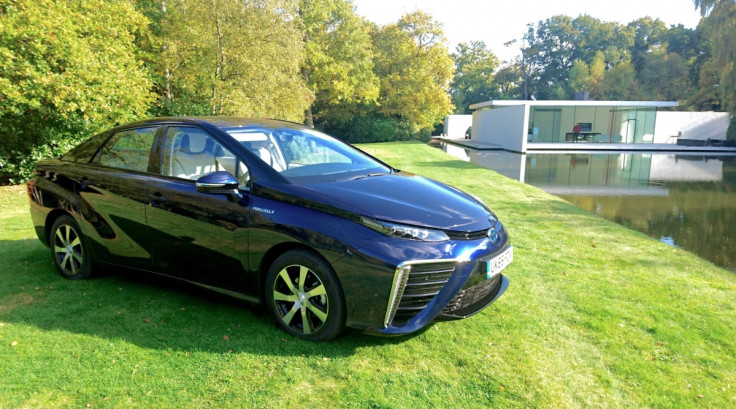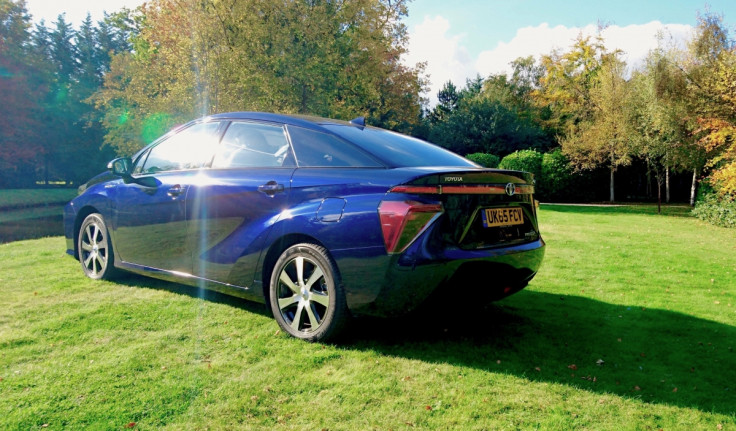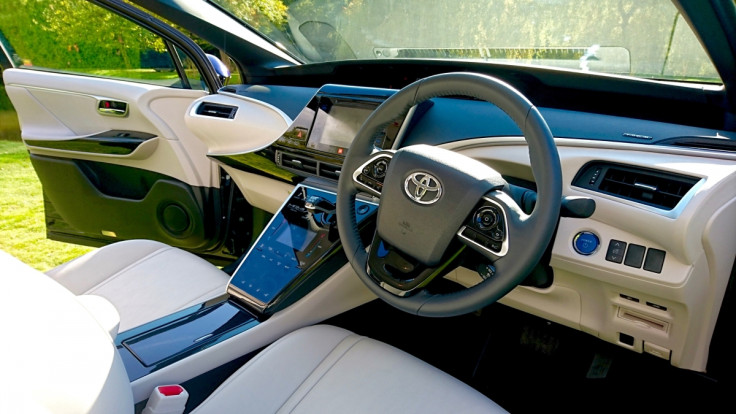Toyota Mirai: First drive in £66,000 hydrogen-powered car with only water emissions [Video]
We drive the hydrogen-powered Toyota Mirai.
Just as we get used to seeing electric cars on our roads, Toyota already wants to look to a new, potentially even greener future. The hydrogen-powered Mirai has just gone on sale and IBTimes UK was among the first to take it out for a spin.
What is the Toyota Mirai and how does it work?
The Mirai combines oxygen in the atmosphere with hydrogen stored in pressurised tanks to produce electricity, which then powers an electric motor, sending 152 horsepower to the front wheels. The car is similar to a Prius, but larger and more luxurious − and so it should be, as the price is an eye-watering £66,000. Toyota says it is applying for customers to receive government grants to lower this by £5,000 (as is the case with electric cars and hybrids), but currently no such discounts exist for hydrogen vehicles.

There is also a small battery pack behind the rear seats. This gathers up energy lost during braking (regenerative braking, as found on the BMW i3 and i8, and all models of Tesla). Unlike in those cars, where brake regeneration is almost exclusively used instead of the brake pedal, you can barely feel it working in the Mirai. Toyota says this is by design to help make driving the car feel as natural as possible. Power stored in the battery is deployed back to the wheels, alongside energy created from the hydrogen and oxygen.
The only byproduct of this reaction is water, which is released by the Mirai every few miles. Alternatively, there is a button on the dashboard to let water out early, preventing the Mirai from relieving itself on your garage floor. And because you are probably asking, Mirai means "future" in Japanese.
What is the Mirai like to drive?
It feels a lot like any other electric car. The gearbox is automatic, there is just one forward gear, and the steering is nice and light. The brakes have very little feel and the car is eerily quiet − aided by the lack of an engine and an increase in sound deadening to combat road and wind noise. The drive system makes the occasional space ship-style noises, but it is otherwise almost silent.
Weighing 1,850kg means the Mirai isn't especially quick. It has the initial electric car surge off the line that makes it feel almost sporty, but accelerating hard to overtake on dual carriageways or motorways and the electric motor doesn't have much to give. You quickly forget about all the science going on beneath you, as the Mirai's driving characteristics blend into the soup of memories you have from driving other normal, everyday cars.

It doesn't look normal...or everyday
No, it doesn't. Those comically large front vents are to keep everything cool, while the rest of the car has been designed with the future in mind. A future where hydrogen and electricity are the answer to an oil shortage; a future where car design is all about gaping vents, sharp lines and LED lights.
I don't particularly like the way the Mirai looks − the lower pair of rear lights look like love handles that have sprung out after getting carried away on an all-inclusive holiday. The height of the roof compared to the diameter of its wheels is also a bit wrong, and the arches over the front and rear wheels make the Mirai look like two different cars stuck together.
The interior is nicer. There is soft leather absolutely everywhere, the seats are electric, the light-up touch panel for controlling music and the sat-nav feels as if it's fallen off the USS Enterprise, and there is loads of space for the driver and passengers.

Is the range better than an electric car?
Yes, it is. Where most electric cars struggle to go much further than 100 miles between lengthy recharges, the Mirai will drive for 300 miles, Toyota claims. Then when it runs out, refilling with hydrogen takes between three and four minutes, similar to refilling with petrol or diesel and 10 times faster than even the fastest electric chargers. A tank of hydrogen costs about £50, which is similar to 300 miles' worth of petrol, but expensive when electricity costs a fraction of this. Remember, the Tesla Model S costs between £50,000 and £100,000, gets a £5,000 government discount, has a range of between 200 and 300 miles, and charges for free in about 45 minutes.
I haven't seen a hydrogen nozzle at my local garage, where do I refuel?
No, us neither. In fact, that are just three hydrogen refuelling stations in the UK − in Hendon, Swindon and near Heathrow airport. Toyota hopes this will double by the end of 2016, and from then on hydrogen cars produced by other manufacturers will help increase coverage further. At least, that's the plan. For now this lack of infrastructure − and the massive price − is reason enough for almost everyone to ignore the Mirai completely.
Meanwhile, there are 80 refuelling stations in Toyota's native Japan, providing hydrogen to the 300 Mirais that have been sold there.

Who is it for then? Has anyone bought one?
Toyota is being realistic here, and only expects to have 12 Mirais on the road by the end of 2015. Four will be delivered to hydrogen-loving Transport for London, to assist with engineering and maintenance work carried out between bus stops and tube stations. The remaining eight cars will be sold to private-hire fleets and businesses, all based in and around London. One firm involved is ITM Power, an energy and clean fuel company.
Research and development in public
Toyota is taking a massive gamble here by opting for hydrogen over electricity − and by effectively doing its research and development in public. Nearly £70,000 for a large Prius with a nice interior is madness, but the company had to start somewhere. I admire its confidence and belief in hydrogen, but the question now is whether energy companies will bother installing refuelling stations when we already have a growing network of increasingly capable, but still far from perfect, car chargers. It could well be a decade before we know if this gamble has paid off.
© Copyright IBTimes 2025. All rights reserved.






















